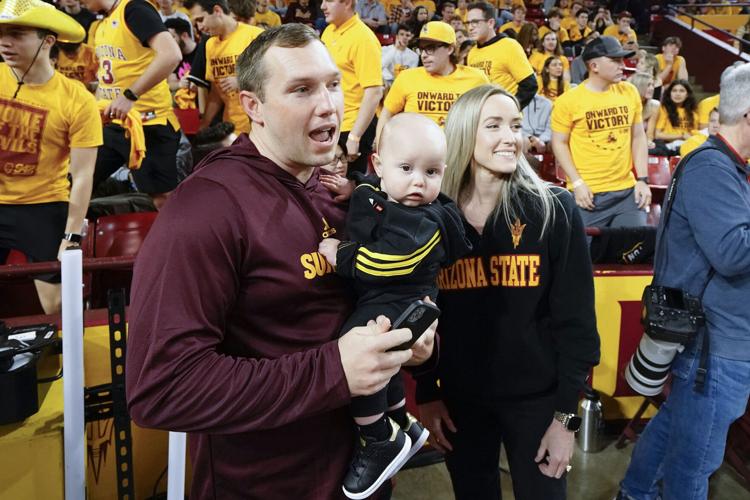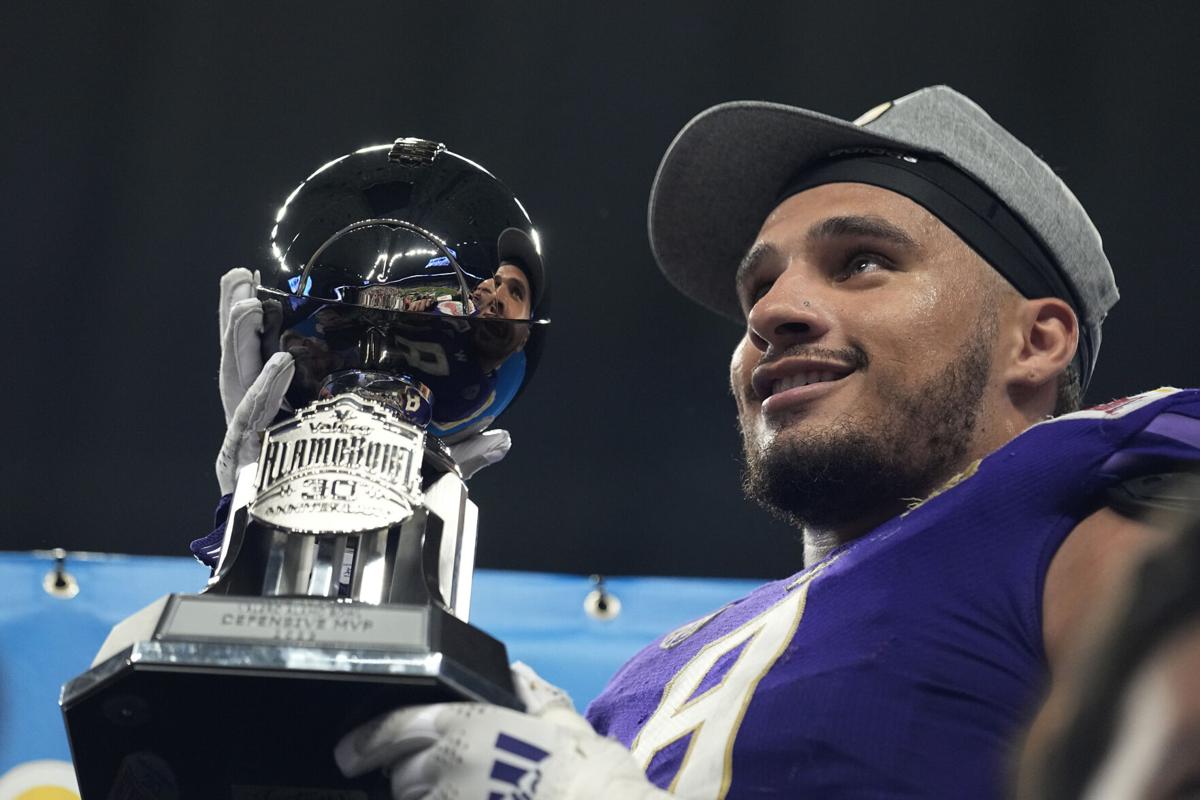Spring practice has ended, the transfer portal is closed, staff changes are complete and the most anticipated Pac-12 season in recent memory is four short months away.
As was the case in January, the conference looks loaded at the top, with at least four teams — and as many as six — expected to appear in the AP preseason poll.
The bottom should be more competitive as well, thanks to coaching changes at Colorado, Stanford and Arizona State.
How do we see the conference race at this point?
Welcome to our post-spring projections.
1. Washington
Four months after the original forecast, we see no reason to remove UW from its frontrunner position. Transfer-portal exits should have limited impact; spring practice brought no serious injuries; and the staff remains intact. The Huskies will field a powerhouse attack with Michael Penix Jr. taking aim at the Heisman Trophy, while the defense possesses two elite edge rushers in Zion Tupuola-Fetui and Bralen Trice. Are there weaknesses? Sure. The secondary has holes, and the interior offensive line must replace key pieces. But when you’re built to score 45 points per game, there’s plenty of margin for error. Previous ranking: 1
2. Utah
A sign of disrespect for the two-time defending champions? More like a reality check. Consider everything that fell into place just for the Utes to qualify for the 2022 title game, then add the layers of challenges lined up in 2023 — from the injury to QB Cam Rising to the elevated competition throughout the conference to the brutal road schedule (USC, Washington and Oregon State). We expect stout play on both lines and an improved kicking game. But will the Utes get the necessary breaks on the margins necessary to produce the conference’s first three-peat of the expansion era? The odds are against them. Previous: 2

Arizona defensive lineman Kyon Barrs, left, chases down NAU quarterback Jeff Widener for a sack in the early going of the first quarter of their game at Arizona Stadium on Sept. 18, 2021.
3. USC
The Trojans ran slightly ahead of schedule in Lincoln Riley’s first season, thanks in part to an otherworldly turnover margin that cannot be repeated. Another recruiting cycle provides the opportunity to patch remaining holes and give quarterback Caleb Williams proper support. Naturally, the offseason focus was on strengthening the defensive line with Bear Alexander (from Georgia), Anthony Lucas (Texas A&M) and Kyon Barrs (Arizona). For now, the Hotline has a believe-it-when-we-see-it approach. We won’t pick the Trojans to finish ahead of Utah after the ’22 results, and Washington has better balance. Previous: 4
4. Oregon
Although the Ducks lost more talent to the transfer portal than they gained, selected arrivals could provide upgrades at key positions (to name two: edge rusher Jordan Burch from South Carolina and receiver Traeshon Holden from Alabama). That said, the defense underperformed late last season, the offensive line must be retooled and quarterback Bo Nix has a new playcaller (Will Stein). Details aside, we’re left with the following assessment: The Ducks have lost ground relative to several title contenders. Last year was their best opening before UW and USC ramped back up under new head coaches. Previous: 3
5. Oregon State
The Beavers broke from their low-profile image, albeit briefly, when they landed quarterback DJ Uiagalelei from Clemson. Otherwise, it was a typical OSU offseason under Jonathan Smith. (Keeping tailback Damien Martinez out of the transfer portal was a major victory.) We have lingering questions about the state of the secondary and offensive line following key departures and wonder if the Beavers can execute efficiently enough, often enough, to offset the talent disparity that exists with other title contenders. Put another way: OSU’s margin for error is forever thin. Navigating that existence two years in a row is difficult. Previous: 5
6. UCLA
All the attention paid to the quarterback competition in the post-Dorian Thompson-Robinson era is ever-so-slightly misguided. The Bruins have quality options with the arrivals of Collin Schlee (Kent State) and five-star recruit Dante Moore, plus veteran Ethan Garbers. Instead, we’re focused on the void left behind by Zach Charbonnet, the Pac-12’s best all-around tailback since Christian McCaffrey. Add the ongoing doubts about the defense — both the talent and the mettle — and we see no clear path to the top tier of the standings. The window was open in ‘22, and UCLA missed its chance. Previous: 6

Washington State’s Nakia Watson, right, runs past Wisconsin’s Jake Chaney during the first half on their game on Sept. 10, 2022. The Cougars won 17-14 in Madison, Wis.
7. Washington State
The talent flow has mostly moved in one direction this spring: out of Pullman. However, the Cougars seemingly retained just enough playmakers on both sides of scrimmage, including tailback Nakia Watson and edge rusher Ron Stone Jr., to prevent a significant backslide. Whether they gain position in the standings depends largely on the offensive line, which struggled in 2022, and quarterback Cam Ward, whose first season at the Power Five level was uneven. Ward has all-conference talent but must improve his downfield accuracy — a critical task for new playcaller Ben Arbuckle. Previous: 7
8. Colorado
The massive, unprecedented roster turnover in Boulder has been the talk of college football this spring and is the basis for our assessment of CU’s prospects under Deion Sanders. Yes, many of the departed players were second-tier talents. Yes, the Buffaloes have acquired several elite playmakers. And yes, Sanders hired quality coordinators. Improvement is inevitable. But it’s extremely difficult to lose 60-something scholarship players and backfill with the depth needed to support a winning product. Once injuries mount in the second half of the season, where will CU turn for help? Previous: 9
9. Arizona
In one corner: momentum. Coach Jedd Fisch changed the roster and the vibe in swift fashion as the Wildcats improved from 1-11 in his first season to 5-7 in his second. In the other corner: reality. Arizona is a basketball school with a small local talent base and little football tradition. For decades, it has been one of the most difficult places to win in the conference. As a result, Fisch must strike quickly. If the upward trajectory stalls — and we believe it will, considering the outflow of talent through the transfer portal — then Arizona’s jump to the next level (bowl eligibility) will become exponentially more difficult in future years. Previous: 8

Arizona State’s new football coach, Kenny Dillingham, watches the ASU-Arizona game with his family on Dec. 31, 2022, in Tempe.
10. Arizona State
First-year coach Kenny Dillingham has done everything right during his six months on the job. And yet, there’s only so much he can do. Years of poor on-field discipline and a misguided recruiting strategy, compounded by the ever-present NCAA investigation, served to create a low ceiling for the Sun Devils in 2023. Dillingham fortified the quarterback depth behind returning starter Trenton Bourguet. But there are simply too many questions on the lines of scrimmage, and in the secondary, to think ASU will find its way to the high side of .500, especially with a punishing schedule in the second half of the season. Previous: 11
11. Cal
The Bay Area Black Hole dominates the bottom tier of our projections, with the Bears having a slightly better outlook than their rival. We expect solid defense in Berkeley, a trademark of the Justin Wilcox era. And while TCU transfer Sam Jackson is the frontrunner at quarterback, he’s merely the best of mediocre options as the program installs a new, modernized playbook under first-year coordinator Jake Spavital. No position is more tenuous than the offensive line, which was a turnstile last season and appears to have limited upside in 2023. For all his gifts, tailback Jaydn Ott cannot run through a wall of defenders. Previous: 10
12. Stanford
The Hotline is modestly optimistic about Stanford’s future under Troy Taylor, who has restructured the recruiting arm and made several smart staff hires. But significant institutional hurdles remain, particularly with limited use of the transfer portal. In the short term, the outlook is gloomy with a chance of bleak, for the Cardinal are woefully undermanned at quarterback, offensive line and defensive line, and the roster is not equipped with enough talent on the perimeter to counteract those deficiencies. On the bright side: Utah is off the schedule, so that’s one less blowout loss on the ledger. Previous: 12
<&rule>
Can Georgia make history and win its third consecutive title? The Bulldogs are the frontrunners, but Alabama and Ohio State aren’t far behind.








